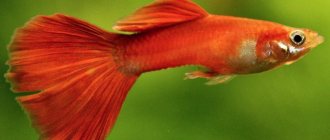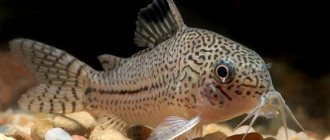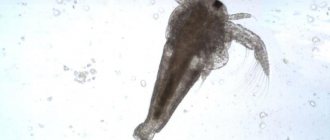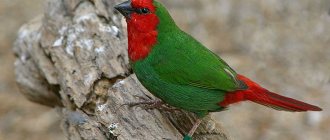Angelfish are popular fish that can be immediately recognized by their beautiful, crescent-shaped body. The fish are brightly colored and do not require complex care, which has made them the favorite abode of aquarists of all levels. Many aquarists breed angelfish at home, but do not know how to do it and where to start. Breeding angelfish at home requires a lot of time and labor. To breed offspring at home, you need to create optimal conditions for the fish, monitor the eggs and prepare a separate tank. But first things first.
Angelfish: how to distinguish a female from a male
Externally, females and males have virtually no differences. Until puberty, differences between females and males do not appear, but in adults, sexual characteristics can be seen if you look closely at the appearance of the fish.
How to distinguish a male from a female angelfish:
- a mature male has a fat hump on his forehead;
- in the male, the pectoral keel protrudes forward;
- with frontal observation, you can notice a wedge in the lower part of the body, which will be sharp in the male and blunt in the female;
- in the female you can find an ovipositor, which is located between the anal fin and the opening, this small growth in females is wider, longer and larger;
- in females the distance from the ovipositor to the anal fin is much greater than in males; the keel of the male grows straight, while in females it is directed backward;
- the female and the male differ in the dorsal fin and the number of stripes: males have an elongated and long fin, and the number of stripes is at least 7-8; females will have no more than 6 stripes.
But these gender differences are not always noticeable. In fish that are bred artificially, it is impossible to distinguish the sex externally. In this case, it is possible to determine the sex of the angelfish by its behavior during the period of pair formation. But this method also does not work well. If there are not enough or no males in the aquarium, the females arrange mating games with each other. From the outside it seems that opposite-sex partners are involved in the process, but two females imitate the natural reproduction process of the angelfish and lay eggs, but they remain unfertilized.
If you definitely decide to breed angelfish at home and are thinking about buying breeders, ask the aquarist for specimens that have already given birth. To determine the male, look at the behavior of the fish: the more active representatives most often turn out to be males. You can buy about 10 angelfish fry with wide fins, and among them there will definitely be at least 1 male.
Pairing
Angelfish are monogamous. Pisces choose a mate from several representatives. It is optimal to purchase a group of 6–10, where the fish will naturally find and form pairs for themselves. It is possible to select bright producers and ensure artificial reproduction. This option will not give a guaranteed result.
Hierarchy of fish
The hierarchy in a common aquarium is built independently. A pair of the largest angelfish occupies the best part of the general aquarium when breeding. Among couples, singles have the most difficult time, they are oppressed and driven away, they get less food.
Breeding angelfish at home
To breed angelfish, you need to create optimal conditions. The quality and temperature of the water plays a big role. To stimulate spawning, the water temperature should not be lower than 27 degrees. Before spawning, it is recommended to feed future parents with live food or frozen food, but it is better to avoid dry food. Fish raised on dry food are smaller in size and have a light color. Often these representatives cannot produce offspring in the future.
When good conditions are created, angelfish reproduce every 14 days. But the aquarist must carefully monitor all stages of spawning in order to remove the fertilized angelfish eggs from the general tank in time.
Temperature and water changes
To stimulate, the water temperature should be increased to 28° C; in fish, at the genetic level, this will be an indicator of the beginning of the warm season and the time of spawning. In nature, it is with the onset of warmth that young individuals begin to break into pairs and lay eggs.
You will also need to regularly do water changes 3-4 times a week, replacing approximately 10% of the total volume. It is important that distilled or pre-boiled water must be added to reduce its hardness. And the temperature should be close to the one in which the pets are used to living.
Preparing angelfish for reproduction
During the spawning period, the female and male must be together. A male's reproductive products mature only when there is a female nearby. You can stimulate angelfish spawning by increasing the water temperature by 2-3 degrees, regularly replacing 10% of the liquid from the reservoir, and lowering the hardness. Before spawning, you need to plant vegetation with large leaves in the tank with fish. You can put decor in the aquarium in the form of a flat plastic tray or ceramic plate. The fish will spawn on it. Reproduction in a community aquarium is acceptable for angelfish, so purchasing a spawning tank is not necessary.
You can find out if a couple is ready to spawn by external changes: the female’s abdomen becomes rounder and her behavior changes. She behaves somewhat aggressively, protecting the chosen place for laying eggs.
Spawning
A couple ready for spawning is identified by their appearance and behavior: a pregnant angelfish stands out with a rounded belly, and the male guards the space and intensively cleans the surface on which the female will lay eggs.
In most cases, cichlid spawning occurs in the late afternoon and lasts 40-90 minutes. The female lays her eggs in straight rows on the surface vacated by the male, pressing tightly against the area. At the same time, the male reproduces movements, fertilizing the eggs.
If the owner removes the eggs from the tank immediately, then repeated spawning is possible after two weeks. The number of eggs is 500-800.
Angelfish laid eggs: what to do
Angelfish have a developed parental instinct, but not as pronounced as cichlids. They last for 3-4 hours after laying eggs, and then they lose interest in the offspring. Immediately after spawning, the female and male monitor the place where the eggs are laid, driving other fish away from it. If the eggs fall from the laying site, they carefully pick them up and put them in place. Whitened, unfertilized eggs are eaten.
To preserve caviar, you can use two methods:
- transfer the leaf with the laid eggs to another tank, having previously prepared it according to the rules;
- Before spawning, place a couple of angelfish in a separate tank and leave them there until the eggs are fertilized.
But you need to carefully monitor the behavior of young parents. Often, after just a few hours of careful care, angelfish turn from caring mothers and fathers into predators that eat their eggs. Therefore, experienced aquarists recommend not waiting for the eating process, but immediately storing the eggs in a separate tank after the angelfish have laid their eggs.
Spawning tank
Before you start breeding, you need to create a special space - a spawning area. It is best to set aside a separate aquarium for it, but if this is not possible, then use a fenced-off space in a common tank. Peculiarities:
- space for a couple;
- lack of decorative ornaments or stones;
- good lighting.
A spawning tank for angelfish is a medium-sized aquarium, about half filled. Without soil, with surfaces for masonry, and the necessary equipment: filter, heater, aerator, light.
The spawning container is created in advance. It is necessary both for the safety of the offspring and for the peace of mind of the couple (there is no need to constantly drive away other fish). In the spawning tank, it is advisable to plant vegetation with strong leaves, place a plastic object or a small container - this will serve as a place for laying eggs (in natural conditions, fish look for a flat and dense surface). After mating, the parents take care of the eggs, but in a stressful situation they can eat the eggs, so sometimes the owner takes care of the eggs, and the parents of their spawning fish are evicted into a common aquarium.
The relocated fish will begin to independently prepare a space for laying eggs.
How to prepare a spawn tank
A tank for growing eggs and breeding fry must meet a number of requirements:
- for growing caviar, a container with a volume of 5-10 liters is enough, which is half filled with water;
- water for the incubator is taken from a common aquarium with scalars;
- a heater is placed in the incubator, which must maintain a temperature of at least 30 degrees;
- An aeration system is definitely needed.
After preparing the tank, it is time to place the eggs. It should be placed close to the aerator so that it is washed by streams of water, but air bubbles should not fall on the eggs.
To prevent the eggs from becoming covered with fungus, add methylthionine chloride or sera mycopur water conditioner to the water. Small plants can be placed at the bottom to act as a natural filter, reducing the risk of nitrogen buildup in the tank. Protozoa will appear in the plants, which are used as food for angelfish fry. The light in the tank with caviar should be on constantly.
The eggs need to be closely monitored until the fry appear, removing whitened kernels daily.
Historical reference
The first description of the angelfish was found in 1823 by Martin Lichtenstein. 1840, Heckel, a famous zoologist from Austria, assigned the Latin name pterophyllum to the angelfish fish, meaning “winged leaf”. In 1931, Baron Georges Cuvier designated this fish as scalaris Platax.
Sagratsky was the first to bring live specimens from their natural habitat to Germany in 1911. Here this species became known under the definition of “Sail fish”. In other countries, angelfish became famous under the name “Angel”. The first successful production of offspring took place under the supervision of the Hamburg aquarium keeper Kvankaru. Reproduction of angelfish in captivity was a closely guarded secret. Since the twentieth year of the 20th century, mass breeding of these wonderful specimens began. The first copies were brought to Russia in 1912. In September of the following year, four more specimens were delivered by an aquarium hobbyist from Petrograd.
Caring for fry
A couple of days after laying, the eggs burst and larvae are born. They have a small tail that helps them move in space. On the fourth day, the head and yolk sacs that serve as food are already visible. Throughout this period, the larva is attached to the egg shell with a thin flagellum. She moves all the time, trying to free herself from him. The connecting flagellum breaks off on the seventh to twelfth day. By this time, the fry have already grown enough and swim well. After the fry are released and become independent, a filter is placed in the tank. To prevent small fish from being pulled into the filter mechanism, a protective mesh is installed on the filter. You cannot overpopulate the tank, so excess fish are placed in another tank. There should be no more than two individuals per liter of water. When an aquarium is overpopulated, an excess of ammonia compounds and nitrites appear in the water, which are harmful to fish. Water changes need to be done daily, about 1/3 of the tank is changed at a time.
After a month, the fry grow up and take on the appearance of adult angelfish. At this stage, they are re-transplanted into a separate larger tank. There should be at least 4 liters of water for each fish. After five to seven days, you can send the grown fish to a common aquarium with other inhabitants.
What to feed the fry
The first days after hatching from the eggs, the larvae feed on substances from the yolk sac to which they are attached. After a week, there are no nutrients left in the pouch and additional feeding needs to be started. Ciliates, daphnia, and brine shrimp are good choices as first food. Fry need to be fed at least 5 times a day.
After a month, the diet is introduced with crushed tubifex, bloodworms, and live food.
Breeding angelfish at home is a troublesome but interesting process. It is not always possible to breed an angelfish at home the first time, but hard work and great desire will bear fruit. The fish will breed every 10-14 days, so there will be plenty of time to practice. Caring for young animals is not difficult, the most difficult thing when breeding is not to miss the moment of fertilization of eggs, to remove them in time and to raise them correctly.
Experiences of aquarium breeders
There are many aquarists who have shared their experience of breeding angelfish with others. Enthusiasts nurse the eggs on their own, while others entrust this task to the parent fish. There are cases when the spawning of an angelfish comes as a surprise to the aquarist.











